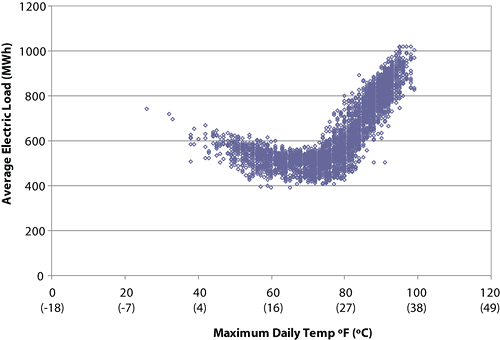Heat Island Impacts
On this page:
- Increased Energy Consumption
- Elevated Emissions of Air Pollutants and Greenhouse Gases
- Compromised Human Health and Comfort
- Impaired Water Quality
On a hot, sunny summer day, roof and pavement surface temperatures can be 50–90°F (27–50°C) hotter than the air, while shaded or moist surfaces—often in more rural surroundings—remain close to air temperatures.1 These surface urban heat islands, particularly during the summer, have multiple impacts and contribute to atmospheric urban heat islands. Air temperatures in cities, particularly after sunset, can be as much as 22°F (12°C) warmer than the air in neighboring, less developed regions.2
Elevated temperatures from urban heat islands, particularly during the summer, can affect a community’s environment and quality of life. While some impacts may be beneficial, such as lengthening the plant-growing season, the majority of them are negative. These impacts include:
- Increased energy consumption;
- Elevated emissions of air pollutants and greenhouse gases;
- Compromised human health and comfort; and
- Impaired water quality.


Credit:Sailor, D. J. 2002. Urban Heat Islands, Opportunities and Challenges for Mitigation and Adaptation. Sample Electric Load Data for New Orleans, LA (NOPSI, 1995). North American Urban Heat Island Summit. Toronto, Canada. 1–4 May 2002. Data courtesy Entergy Corporation.
Increased Energy Consumption
Elevated summertime temperatures in cities increase energy demand for cooling. Research shows that electricity demand for cooling increases 1.5–2.0% for every 1°F (0.6°C) increase in air temperatures, starting from 68 to 77°F (20 to 25°C), suggesting that 5–10% of community-wide demand for electricity is used to compensate for the heat island effect.2
Urban heat islands increase overall electricity demand, as well as peak demand, which generally occurs on hot summer weekday afternoons, when offices and homes are running cooling systems, lights, and appliances. During extreme heat events, which are exacerbated by urban heat islands, the resulting demand for cooling can overload systems and require a utility to institute controlled, rolling brownouts or blackouts to avoid power outages.
Elevated Emissions of Air Pollutants and Greenhouse Gases
As described above, urban heat islands raise demand for electrical energy in summer. Companies that supply electricity typically rely on fossil fuel power plants to meet much of this demand, which in turn leads to an increase in air pollutant and greenhouse gas emissions. The primary pollutants from power plants include:
- sulfur dioxide (SO2)
- nitrogen oxides (NOx)
- particulate matter (PM)
- carbon monoxide (CO) and
- mercury (Hg).
These pollutants are harmful to human health and also contribute to complex air quality problems such as the formation of ground-level ozone (smog), fine particulate matter, and acid rain. Increased use of fossil-fuel-powered plants also increases emissions of greenhouse gases, such as carbon dioxide (CO2), which contribute to global climate change.
In addition to their impact on energy-related emissions, elevated temperatures can directly increase the rate of ground-level ozone formation. Ground-level ozone is formed when NOx and volatile organic compounds (VOCs) react in the presence of sunlight and hot weather. If all other variables are equal, such as the level of precursor emissions in the air and wind speed and direction, more ground-level ozone will form as the environment becomes sunnier and hotter.
Compromised Human Health and Comfort
Increased daytime temperatures, reduced nighttime cooling, and higher air pollution levels associated with urban heat islands can affect human health by contributing to general discomfort, respiratory difficulties, heat cramps and exhaustion, non-fatal heat stroke, and heat-related mortality.
Heat islands can also exacerbate the impact of heat waves, which are periods of abnormally hot, and often humid, weather. Sensitive populations, such as children, older adults, and those with existing health conditions, are at particular risk from these events.
Excessive heat events, or abrupt and dramatic temperature increases, are particularly dangerous and can result in above-average rates of mortality. The Centers for Disease Control and Prevention estimates that from 1979–2003, excessive heat exposure contributed to more than 8,000 premature deaths in the United States.3 This figure exceeds the number of mortalities resulting from hurricanes, lightning, tornadoes, floods, and earthquakes combined.
Impaired Water Quality
High pavement and rooftop surface temperatures can heat stormwater runoff. Tests have shown that pavements that are 100ºF (38°C) can elevate initial rainwater temperature from roughly 70ºF (21ºC) to over 95ºF (35ºC).4 This heated stormwater generally becomes runoff, which drains into storm sewers and raises water temperatures as it is released into streams, rivers, ponds, and lakes.
Water temperature affects all aspects of aquatic life, especially the metabolism and reproduction of many aquatic species. Rapid temperature changes in aquatic ecosystems resulting from warm stormwater runoff can be particularly stressful, even fatal to aquatic life.
References
- Berdahl P. and S. Bretz. 1997. Preliminary survey of the solar reflectance of cool roofing materials. Energy and Buildings 25:149-158.
- Akbari, H. 2005. Energy Saving Potentials and Air Quality Benefits of Urban Heat Island Mitigation (PDF) (19 pp, 251K). Lawrence Berkeley National Laboratory.
- Center for Disease Control and Prevention. 2006. Extreme Heat: A Prevention Guide to Promote Your Personal Health and Safety.
- James, W. 2002. Green roads: research into permeable pavers. Stormwater 3(2):48-40.
